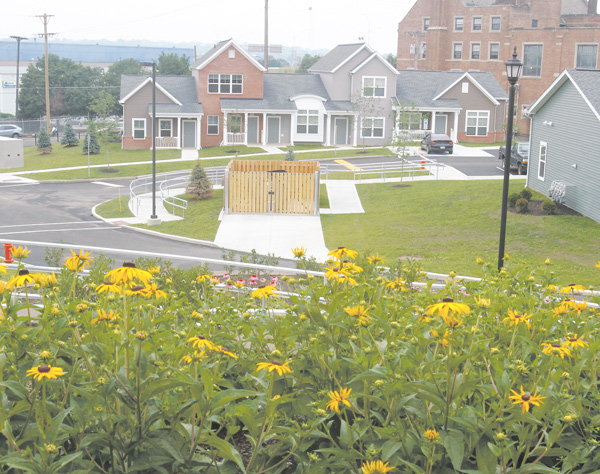Westlake Terrace’s replacement is complete


The 120-apartment Village at Arlington replaces the last remaining section of Westlake Terrace, which was one of the first public housing projects in the country.
YOUNGSTOWN
The Youngstown Metropolitan Housing Authority will soon formally dedicate the newly constructed Village at Arlington, which has replaced the last remaining section of Westlake Terrace.
The formal dedication next month will mark the end of a 15-year effort to replace the entire 1940- vintage, barracks-style Westlake Terrace apartments, which was one of the first public housing projects in the nation, and to revitalize the neighborhood.
The replacement of the first 400 Westlake apartments with new housing in the Arlington Heights community was completed in 2008. That new community includes 75 rental apartments, 30 owner-occupied townhouse units, a recreation center and a park.
The newly opened $13.5 million, 120-apartment Village at Arlington replaces the final 218 Westlake apartments, with the first half of the village having opened last November and the remainder in March. The first half of the village is fully occupied, and YMHA officials hope to have the second half fully occupied in the next two weeks.
“We’ve gone through so much to get it done,” said Carmelita Douglas, YMHA executive director. “You have a neighborhood, not a project,” she said of the new communities that replaced Westlake. She added that it has been rewarding to see “the whole neighborhood being revitalized.”
Unlike Westlake, where the apartments faced the streets, the Village at Arlington’s townhouse-style apartments face inwardly into the development and toward one another to provide more of a sense of neighborhood, said Lester Walker, YMHA project manager.
“You can sit on your porch and look at your neighbor’s porch, and, if something looks wrong over there at your neighbor’s, you’re able to see that” in an inward-facing community, Douglas said.
Barracks-style traditional public housing “stigmatizes the residents” and draws negative attention to the community, Walker said.
“This blends in,” Walker said of the new village. “This is what housing should be,” he added.
“They used to call it ‘the badlands,’” Alice Freeman said of Westlake, where she lived for 43 years, raised her children and served as resident council president. “I call this the new frontier,” Freeman said of the village, where she now lives and again serves as resident council president.
In the Village at Arlington, Freeman said she feels secure. “You don’t have the drug scene” and unauthorized apartment occupants that plagued Westlake, Freeman said.
“Westlake was always known for drugs and havens for people to hang out, and crime was really bad,” said Shelly Rauschenbach, village community manager. “Here, we’ve put in a brand-new development, and the people that have moved here genuinely have a heart interest in this property,” she added.
In the Village, drug activity and other crime has so far been minimal to nonexistent, Rauschenbach said.
The housing development contains a mix of single people, families with children and older adults, the manager said. “They all seem to provide each other with the support necessary to keep a community upstanding,” she said.
Built and managed by the privately owned NRP Group LLC of Cleveland and owned by the housing authority, the Village at Arlington consists of one-, two- and three-bedroom apartments.
YMHA, the city and housing tax credits sold to investors funded construction.
All Westlake Terrace tenants qualified for federally subsidized public housing, meaning their household incomes were 30 percent or less of the area median gross income, or AMGI.
The Village at Arlington is a mixed-income, affordable-housing community, however, where 45 of the apartments are federally subsidized units for very low-income people, and the remainder are for households with incomes between 30 percent and 60 percent of the area median gross income.
Village apartments occupied by higher- and lower-income people are indistinguishable from one another in their appearance, Douglas said.
The AMGI is the area’s average annual household income before any tax withholdings, as determined by the U.S. Department of Housing and Urban Development.
The AMGI for a four-person household in the Youngstown-Warren-Boardman area is $53,900 a year.
Village at Arlington rents vary according to household income and apartment size, with the maximum monthly rent being $869 for a three-bedroom apartment, including all utilities.
The monthly rent for a comparable new apartment of that size on the open market here with all utilities included likely would be between $1,000 and $1,200, Rauschenbach added.
“The mix of the tenants is also a mix of income levels, but everyone takes care of their homes in the same way, and I think they have a lot of pride in the property that they all take part in taking care of,” said Joe Welker, NRP’s regional property manager.
The mixed-income community concept can promote upward mobility if an employed, higher-income resident can refer a lower-income neighbor to his or her employer for a job opportunity, Douglas observed.
All utilities are included in the rents for Village at Arlington apartments, all of which have central air conditioning, built-in security alarm systems, handicapped-accessible first floors with first-floor restrooms, and angled parking spaces and sidewalks with curb cuts in front of each apartment.
For fire prevention, each apartment has electric stove elements that automatically shut off if they get too hot.
All apartments have water-conserving shower heads and toilet tanks and energy-efficient fluorescent lighting, stoves, refrigerators, dishwashers and windows.
Although each apartment has washer and dryer hookups, the complex also has a central coin-operated laundry room. That central laundry room is housed with a computer lab and community room in the building that contains the leasing office. The village also features a community garden.
 43
43
